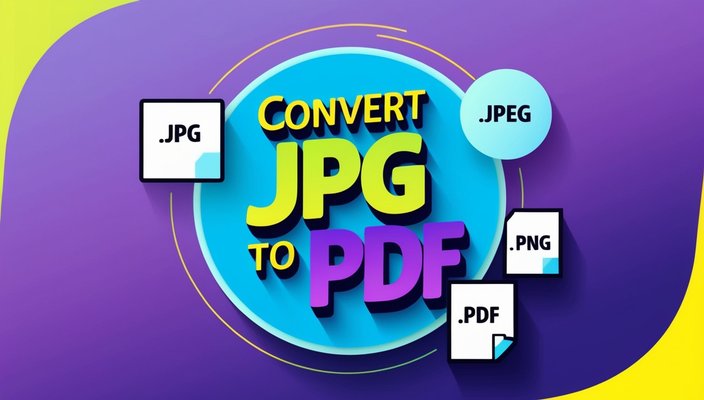
I'll be honest with you: I used to think converting JPG images to PDF was one of those "simple" tasks that shouldn't take more than five minutes. Boy, was I wrong. After spending an entire afternoon trying to preserve the quality of my travel photos while converting them into a portfolio PDF—and ending up with images that looked like they'd been photocopied underwater—I realized there's actually a lot more to this than meets the eye.
Whether you're compiling photos for a presentation, creating a digital portfolio, or just trying to organize your images into manageable PDFs, getting the conversion right the first time saves you hours of frustration. Trust me, I've been down this rabbit hole more times than I care to admit.
The good news? Once you understand a few key principles about image quality and file formats, converting JPGs to PDF becomes straightforward. Even better—you don't need expensive software to do it right. Let me walk you through everything I wish someone had told me before I started this journey.
The Great JPG vs JPEG
Okay, let's clear this up right away because it confused the heck out of me for way too long. JPG and JPEG are literally the same format. The only difference is the file extension. Back in the day, some operating systems could only handle three-letter file extensions, so JPEG became JPG. That's it. That's the whole mystery.
So when you're looking for a JPG to PDF converter free tool, it'll work just fine with your .jpeg files too. Same compression, same quality, same everything. I spent embarrassing amounts of time early on wondering why some of my photos ended in .jpg and others in .jpeg—turns out it doesn't matter one bit for conversion purposes.
Quick File Extension Facts
.jpg files: More common on Windows and web platforms. Same quality and compression as JPEG.
.jpeg files: Often used on Mac systems and photography applications. Completely interchangeable with JPG.
For PDF conversion: Both work identically in any quality JPG to PDF converter.
What Actually Matters
Instead of worrying about JPG vs JPEG, focus on:
• Original image resolution and quality
• Compression settings during conversion
• Target file size requirements
• Whether you need batch conversion capabilities
Quality Preservation: The Make-or-Break Factor
Here's where things get interesting. I learned this the hard way when I converted a bunch of high-resolution product photos for a client presentation, only to discover they looked pixelated and terrible in the final PDF. The problem wasn't the converter—it was that I didn't understand how image compression works during JPG to PDF conversion.
The Golden Rule of Quality Preservation
Never let your converter re-compress images that are already compressed. JPG files are already compressed, so the best JPEG to PDF converters simply wrap your existing image data into a PDF container without additional compression. Think of it like putting your photo in a new folder rather than making a photocopy of it.
The converters that maintain the best quality work like this: they take your JPG file and embed it directly into the PDF structure. No re-encoding, no additional compression, no quality loss. It's basically like stapling your photo to a piece of paper rather than scanning it again.
Quality Preservation Techniques That Actually Work
Use Native Resolution
Don't resize images during conversion unless absolutely necessary. If your original JPG is 3000x2000 pixels and looks good, keep it that way. Resizing always introduces some quality loss.
Avoid Double Compression
Choose converters that embed original JPG data rather than re-encoding. Look for tools that explicitly mention 'lossless conversion' or 'direct embedding.'
Check DPI Settings
For print-quality PDFs, ensure your converter maintains or sets DPI to 300. For web viewing, 150 DPI is usually sufficient and keeps file sizes manageable.
Preview Before Converting
Always preview your PDF before finalizing. Quality issues are easier to spot in the preview than in the final file, and you can adjust settings accordingly.
Pro tip: If you're working with photos from modern smartphones or cameras, they're probably already optimized for their intended use. A good JPG to PDF converter free tool will respect those original settings rather than trying to "improve" them.
Batch Conversion: Because Life's Too Short for One-by-One
Let me tell you about the time I needed to convert 47 product images for an e-commerce catalog. I started doing them one by one, and after about twenty minutes of clicking "convert," "download," "select next file," I realized I was going to be there all day. That's when I discovered the beauty of batch conversion—and also learned that not all batch converters are created equal.
Smart Batch Conversion Strategy
Group similar images together: photos with similar dimensions, resolution, and intended use should be batched together. This lets you apply consistent settings across the group and ensures uniform quality in your final PDF.
The best JPG to PDF online batch converters let you drag and drop multiple files, set conversion parameters once, and then process everything automatically. But here's what I learned: you want to maintain some control over the process. Fully automatic batch conversion can sometimes apply the wrong settings to certain images.
When Batch Conversion Works Great
• Product photos with consistent lighting and dimensions
• Scanned documents of the same type
• Photos from the same camera/shoot
• Images that will be viewed at the same size
Our batch JPG to PDF converter handles these scenarios beautifully with minimal quality loss.
When to Convert Individually
• Mixed image types (photos + graphics)
• Different intended uses (print vs web)
• Varying quality requirements
• Images that need specific optimization
For complex projects, individual conversion gives you precise control over each image's final quality.
Mobile vs Desktop: The Conversion Platform Battle
I used to be a desktop-only person for anything "serious" like file conversion. Then I found myself stuck in an airport with only my phone, needing to convert some photos for a client who was waiting for them. That experience taught me a lot about the pros and cons of mobile conversion—and honestly changed how I think about productivity tools in general.
The reality is that mobile convert JPG to PDF tools have gotten surprisingly good. They're perfect for quick jobs, on-the-go conversions, and situations where you just need something that works. But they do have limitations that you should understand before diving in.
Mobile Conversion: The Real Talk
Great for: Quick conversions, single images, photos taken with your phone camera, emergency situations when you need a PDF right now.
Not ideal for: Large batch jobs, high-resolution professional photos, precise quality control, complex file organization.
Sweet spot: Converting 1-5 images with decent quality requirements. Most mobile converters handle this beautifully.
Desktop conversion still wins for serious work. You get better quality control, more format options, easier file management, and the ability to really see what you're doing on a larger screen. Plus, if you're working with large files or doing batch conversions, desktop tools typically handle the processing much more efficiently.
File Size Optimization: Finding the Sweet Spot
File size optimization is where I see people make the most mistakes. I've watched colleagues create beautiful, high-quality PDFs that are so large they can't email them, and I've seen others compress their images so aggressively that they end up looking like abstract art. The trick is finding that sweet spot between quality and file size.
Here's my approach: start with the end goal. Are you emailing this PDF? Most email systems cap attachments at 25MB, so keep that in mind. Posting it on a website? Consider your users' internet speeds. Printing it? You'll need higher quality and larger file sizes are acceptable.
File Size Optimization Strategies
Email-Friendly PDFs
Target 10-15MB max for email attachments. Use 150 DPI for images, and consider reducing dimensions of very large photos. Most recipients won't notice the difference on their screens.
Web Viewing PDFs
Optimize for 5-10MB for smooth web viewing. Use 96-150 DPI, and compress images moderately. Fast loading is more important than perfect quality for web use.
Print-Ready PDFs
Use 300 DPI and maintain original image quality. File size is less critical than quality. Don't compress images if they'll be printed larger than screen size.
Archive/Storage PDFs
Balance quality with storage costs. 200-250 DPI often provides good quality while keeping file sizes reasonable for long-term storage.
One thing that surprised me: sometimes a well-optimized PDF with moderate compression looks better than an uncompressed one when viewed on screen. This is because PDF viewers apply their own rendering algorithms, and they often work better with appropriately compressed images.
Security: What You Need to Know About Online Converters
Let's talk about the elephant in the room: security. When you upload your images to an online JPG to PDF converter free service, what happens to them? This question became very real for me when I needed to convert some confidential business documents and realized I had no idea what the conversion service was doing with my files after processing.
Security Red Flags to Watch For
• Services that don't specify file deletion policies
• Converters that require account creation for basic conversion
• Tools that ask for more permissions than necessary
• Services without HTTPS encryption
• Converters that want to access your cloud storage unnecessarily
The good news is that reputable JPEG to PDF conversion services are pretty transparent about their security practices. Look for services that explicitly state they delete files after conversion, use encrypted connections (HTTPS), and don't require unnecessary permissions or account creation.
For Sensitive Documents
Use offline conversion tools or desktop software when dealing with confidential information. Even trustworthy online services involve uploading your files to someone else's servers.
Consider browser-based converters that process files locally rather than uploading them to remote servers.
For General Use
Established online converters with clear privacy policies are generally safe for non-sensitive images like vacation photos, product images, or general documentation.
Our JPG to PDF converter processes files securely and deletes them immediately after conversion.
Beyond JPG: Converting PNG, WEBP, and Other Formats
While we're talking about JPG conversion, let's address the other image formats you might encounter. I learned about this when a client sent me a bunch of PNG files for a project, and I spent way too long trying to figure out why they were converting differently than my usual JPG files.
PNG files are different beasts entirely. They're uncompressed (or losslessly compressed), which means they maintain perfect quality but are often much larger than JPGs. When converting PNG to PDF, you have some interesting options that don't exist with JPG conversion.
Format-Specific Conversion Tips
PNG to PDF: Perfect for graphics, logos, and images with transparent backgrounds. Keep original quality if file size allows, or convert to JPG format during PDF creation for smaller files.
WEBP to PDF: Modern web format with excellent compression. Most converters handle these well, but double-check quality since WEBP uses different compression algorithms.
Mixed formats in one PDF: Totally doable. Each image gets converted using appropriate settings for its format.
WEBP is interesting because it's Google's format designed for web use. It often provides better compression than JPG while maintaining similar quality. However, not all PDF viewers handle embedded WEBP perfectly, so I usually convert WEBP images to JPG format during the PDF creation process for maximum compatibility.
Choosing the Right Free Converter: What Actually Matters
After trying dozens of different JPG to PDF online converters, I've developed a pretty good sense of what separates the excellent ones from the mediocre ones. It's not always what you'd expect—sometimes the fanciest-looking tools produce the worst results, while simple interfaces hide powerful conversion engines.
Must-Have Features in a Quality Converter
Lossless Conversion Option
The ability to embed original JPG data without recompression. This should be the default setting, not a hidden option buried in advanced settings.
Batch Processing
Drag-and-drop multiple files with consistent quality settings. Should handle at least 20-30 images in a single batch without choking.
Quality Control
Preview functionality and adjustable DPI/quality settings. You should be able to see what you're getting before committing to the conversion.
Format Flexibility
Support for various input formats (JPG, PNG, WEBP) and output options (different PDF standards, compression levels).
Speed matters too, but not in the way you might think. The fastest converters often sacrifice quality for speed. I'd rather wait an extra 30 seconds for a conversion that preserves my image quality than get a compressed mess in 5 seconds.
The Mobile Photography Factor
Since most of us are taking photos with our phones these days, let's talk about mobile photography and PDF conversion. Phone cameras have gotten incredibly good, but they also create some unique challenges when you're converting to PDF.
Modern smartphones often take photos in HEIC format (especially iPhones) or use computational photography that creates images with specific characteristics. When you're looking for a convert JPG to PDF solution, make sure it can handle whatever format your phone actually produces.
Mobile Photo Conversion Tips
• Check your phone's camera settings—some default to HEIC instead of JPG
• Be aware that "Live Photos" and motion photos won't convert to PDF
• Consider editing photos on your phone before conversion for better results
• Mobile photos often benefit from slight compression during PDF conversion
When Mobile Photos Shine in PDFs
• Travel documentation and photo journals
• Quick product catalogs or inventory
• Real estate listings and property documentation
• Event photography collections
Mobile photos convert beautifully when you understand their characteristics.
Advanced Tips for Power Users
If you're doing a lot of JPG to PDF conversion, here are some advanced techniques I've picked up that can save you significant time and improve your results:
Organize before converting: Create a folder structure that matches how you want your PDFs organized. It's much easier to convert organized images than to try to sort them after conversion.
Use consistent naming: If you're creating multiple PDFs or doing batch conversions, develop a naming convention that makes sense six months from now. Trust me on this one—"IMG_1234_final_v2.pdf" tells you nothing when you need to find it later.
Consider PDF/A format: For archival purposes or long-term storage, PDF/A format ensures your images will be viewable decades from now. Not all converters offer this, but it's worth looking for if you're creating important documents.
My Personal Conversion Workflow
After years of trial and error, here's the workflow that works best for me. Feel free to adapt it to your needs:
The 5-Step Quality Conversion Process
1. Assess your images: Check resolution, format, and intended use before starting.
2. Group similar images: Batch similar photos together for consistent settings.
3. Choose appropriate settings: Match DPI and compression to your end goal.
4. Convert with preview: Always preview before finalizing.
5. Test the final PDF: Open it in your intended viewing environment to confirm quality.
This process takes a few extra minutes upfront but saves hours of re-work later. I learned this the hard way after having to redo several important projects because I rushed through the conversion process.
The Bottom Line: Quality Without the Premium Price
Here's what I've learned after converting thousands of images: you absolutely do not need expensive software to get professional-quality results. The key is understanding how image compression works and choosing tools that respect your original image data rather than trying to "improve" it.
Good JPG to PDF converter free tools are abundant, and they can produce results that rival premium software. The difference isn't in the conversion quality—it's in the convenience features, customer support, and advanced options that most people don't actually need.
Whether you're converting a single photo for a quick email or creating a comprehensive PDF portfolio, the principles remain the same: preserve original quality, understand your output requirements, and choose tools that give you appropriate control over the process.
Ready to Convert Like a Pro?
Stop settling for blurry, oversized, or problematic PDFs. Our free JPG to PDF converter incorporates all the quality preservation techniques discussed in this guide.
SEO Specialist, Digital Marketing Expert
Lukesh Pillai is a seasoned SEO specialist and digital marketing expert with over five years of experience in the industry. His expertise spans search engine optimization, content strategy, and …


